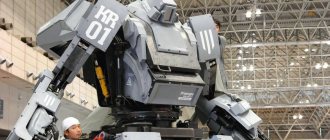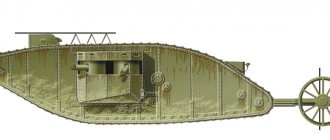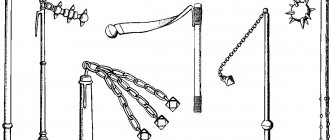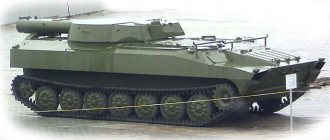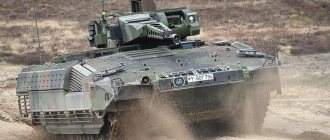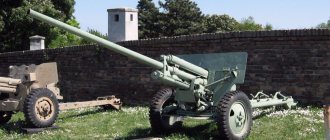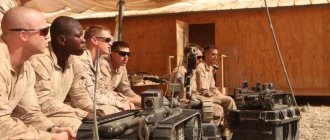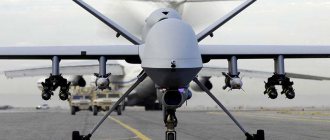Robotization of ground armies has occupied the minds of military personnel around the world since the beginning of the last century. The development of technology has made it possible to begin the practical implementation of these ideas only now. The growth of military budgets in the last decade has led to an avalanche-like increase in the number of projects in the field of artificial intelligence and combat robotics. Izvestia talks about the current state of affairs and immediate prospects.
High radiation exposure: a robot resistant to any radiation has been created in the Russian Federation
The device would be useful in eliminating accidents like Chernobyl
Human bodies for human cities
Part of the reason people fixate on humanoid robots is a lack of imagination, clinging to what they've seen in movies.
But in the future, anthropomorphic robots will likely be deployed on the battlefield. Given the rate of urbanization and population growth, the US War College predicts that in the coming decades, more and more battles will take place in highly urbanized places - that is, in places designed for things that move and look like people. “If you're thinking of a robot that can move around a building,” says Singer, “remember that buildings are designed for people of a certain height or shape. This is a real design problem. We build the world a certain way."
Researchers are trying to create robots that can move around in the simplest human architecture. In 2008, the TechX Challenge offered a $700,000 prize to the team whose robot could autonomously enter a building, climb the stairs, and press the button for a certain floor in the elevator. Nobody won it. Most of the robots didn't even make it to the front door. And it didn’t even need to be opened.
But technology does not stand still. Recently, a team from Stanford built a robot that can not only press the desired button, but also recognize buttons on an elevator panel that it had not seen before. It was a leap in development. The robot had working “eyes” and a “finger” - two critical pieces of equipment that people need to move around buildings. But the stairs - the same unnatural human invention as the elevator - could stop him.
Conversely, bomb disposal robots currently in use typically ride on wheels, tracks, or a combination of these methods. Many of them can climb ladders, albeit clumsily.
Call of Duty: Infinite Warfare
According to Singer, systems with legs are worth developing. Different propulsion systems are suited to different types of terrain - wheels are fast but require flat surfaces, tracks sacrifice speed for the ability to move over rocks - but human legs are versatile. “You can walk on anything,” he says, “on flat ground, steps or a mountain. You can walk on both concrete and sand.”
Mastering movement in buildings is also necessary, since the military needs robots capable of clearing buildings - an extremely dangerous task. One robot playing the role is Endeavor Robotics' 110 FirstLook, a wearable drone that can be thrown through a window and then controlled remotely, allowing soldiers to study a building through the robot's cameras. The Pentagon hopes the range of future manned and unmanned systems will range from Iron Man-style exoskeletons to door-to-door robots that allow soldiers to clear rooms without causing casualties. Such systems may protect the lives of soldiers, but make wars even more terrible.
This dynamic can be seen in Titanfall and Infinite Warfare. In Infinite Warfare, the role of room-storming forces is played by defensive robots from the Settlement Defense Front, driving players out of fortified positions and often breaking into rooms. In Titanfall 2, the player can hack robots and turn them into allies so that they shield you from bullets while spraying fire on your enemies. In both cases, there is a premonition that robots will someday be able to replace human soldiers in too dangerous places. This trend is already developing.
A robot for every task, a task for every robot
In Titanfall 2 and Infinite Warfare there are not only combat robots - there are also industrial models.
You can get into a spaceship or climb into a mine on Mercury and find robots doing work in conditions that humans would not survive. It is in these conditions that military and industrial robots are used today - but, unlike their UAV cousins, ground robots today mainly protect human life, rather than take it.
Modern military robots mainly perform the function of bomb disposal (Explosive Ordinance Disposal, EOD), or work in the presence of radioactive or chemically active materials. After the Fukushima plant accident in 2011, Tokyo Electric Power Company hired a contractor to survey the site using a T-Hawk drone. Drones are still used in Fukushima today; Last year, a specially built drone transmitted video and radiation readings from inside the reactor after operating for three hours in conditions in which a person would not survive for even a few seconds. This is in some ways the best use case for robots - performing tasks that, in past disasters such as Chernobyl, took the lives of workers.
As technology advances, military planners are looking for other dangerous jobs for robots. For example, automatically moving convoys can reduce the number of victims of mines. Robots can increase the amount of supplies they can carry, reducing the number of trips back to base and protecting infantry from fire as they try to get ammunition and equipment to the battlefield.
Call of Duty: Infinite Warfare
This year, Israeli company Tactical Robotics conducted the first successful flight of the AirMule, an autonomous aerial rescue drone capable of landing on and taking off from the battlefield in places where a traditional evacuation helicopter would not fit. Johns Hopkins has proven that drones can deliver blood, and Japan is testing the delivery of defibrillators.
You'll notice that these drones look more like the equipment they're replacing than the people whose jobs they're taking away—and that's intended. The robot's task is to fulfill its function, and not to imitate people. The medical robot will not look like a human medic, but like a robotic ambulance: Robotic Extraction Vehicle/Robotic Evacuation Vehicle (REX/REV). This is an automatically moving machine equipped with a robotic stretcher. According to Singer, the reasons for this trend are practical and driven by the market.
“If you're making cars in a factory, the changes needed to make self-driving cars cost less money if you just do the same thing,” he says. “We are changing software, not hardware.” He adds that customers - including the military - are also more willing to buy familiar equipment.
This is especially important for the military, since the generals who have the final say in procurement are quite elderly and do not have much confidence in technology. For example, last year a captain at the Army Cyber Institute created a device for jamming drones using a Raspberry Pi. It could have been made in the form of a radio, but he made it in the form of a weapon so that the higher ranks would understand it more clearly. “When all this is placed on a rifle base, it is easier for the command to digest,” he explained to Popular Mechanics. “They took aim, fired, fell.”
The ability to explain complex technology to bosses will be key for the next administration. Trump admitted that in 2007 he did not have a computer, and he read emails and online articles from printouts. For these officials, familiar-looking technology will have an advantage when making purchasing decisions.
But you can't just modify current machines, as this stunts innovation and reduces efficiency. Mine clearance robots in the form of tractors may sell better now, but eventually the empty driver's compartment will be considered a waste of resources and eliminated. Part of the benefit of autonomous systems is the ability to eliminate systems that have become unnecessary, saving fuel and freeing up space for cargo or equipment.
In addition, robotics may be lagging behind due to attempts to replicate human movements rather than improve upon them. And while it's true that legs are useful for moving around, the bipedal system isn't necessarily the most efficient. Multi-legged robots could provide more stable shooting platforms and solve balancing problems - meaning the first working robots with legs could look more like spiders or dogs than humans. In the future, combat robots may borrow design ideas from nature, as in Horizon: Zero Dawn, a game about cavemen fighting robots.
There are many projects trying to replicate biological systems in robots. European researchers are working on an artificial eye that replicates the compound eyes of insects. MIT is making a cheetah-like robot - with DARPA money - that can run at high speeds and jump over obstacles. Other scientists are making drones that can feed on energy from high-voltage power lines, landing on them like birds, or “eating” organic matter and burning it for energy (journalists really didn’t like this robot when they learned that it could theoretically feed on corpses) . One team wants to build a sensor that replicates a hawk's unique vision, something like a picture-in-picture system on a TV.
“Hawks are able to scan large areas while concentrating on prey,” says Singer. “Our high-altitude drones should have such a system.”
But, according to him, the most interesting thing that robots borrow from nature is disaggregated consciousness. We think of robots as large, intelligent systems that resemble humans, but the focus is now on swarms of small robots, each with a specific task, resembling ants that can carry out coordinated attacks or surveillance.
“Any individual ant is not particularly smart,” says Singer, “but together they are capable of performing very complex tasks. “The same dilemma appears in robotics - will one large super-smart system complete the task, or will many small parts work?”
And swarms of robots are not a speculative technology; it already works. Disney launched an aerial light show in Orlando, in which 300 LED-lit drones create images of a Christmas tree and flying birds to the music. It's easy to imagine a frightening future in which such drones will not carry LEDs, but cluster bombs.
Someone is studying ants, someone is trying to imitate the features of hawks, and it is possible that in the future robots, even those similar to humans, will become technological hybrids of different creatures. Robots of the future may run like cheetahs, see the world like flies and have human hands.
And since robots are unnatural creatures, they do not have to obey the laws of biology and evolution. There is no animal on Earth with eyes on its hands - but modern bomb disposal robots have this feature, since they are used to clear mines. Combat robots may not be humanoid or animalistic, but more reminiscent of monsters from Lovecraft's books, with a lot of arms and eyes.
It’s interesting to fantasize about this topic until you imagine yourself in the role of a soldier facing such a monster on the battlefield.
Fiction follows reality, and then reality follows fiction.
Despite all these possibilities, the gaming industry has not moved away from traditional sci-fi concepts of fighting robots - more like the Tin Woodman or Metropolis than modern fighting robots.
As a consultant to game studios, Singer tries to convince them to create more grounded systems, but designers remain biased. "You say, 'That's not realistic,' and they say, 'But robots should look like that,'" explains Singer. "Science fiction influences our understanding of the future."
But constantly feeding the culture with such images of robots has the backlash effect of causing military leaders, having seen enough of Hollywood robots, to believe that technology will take us there. “In the military aspect, the same problem: everyone thinks that the design should be futuristic because it looks futuristic. It's a vicious circle."
But even though Titanfall 2 and Infinite Warfare do this, they get a lot of things right. According to modern military theories, robots will accompany and complement humans in battle, rather than replace them. The Marine Corps military laboratory is coming up with the MAARS system - a remote-controlled tank equipped with cameras, an M240 machine gun and a grenade launcher.
Call of Duty
Meanwhile, the Russian unmanned Uran-9 tank is trying to combine anti-personnel and armor-piercing weapons in a small volume, with a team operating the vehicle from a safe distance. These mini-tanks are similar to the robotic companions from Titanfall 2 or Infinite Warfare, and their task is much the same - to complement the firepower of the infantry and protect it.
When Reyes commands an armored 'Mech in Infinite Warfare, he is essentially operating the system remotely, much in the same way that the Marines imagine the MAARS system working, or the Russians control the Uran-9. Like Infinite Warfare's autonomous grenades - explosives with crab-like legs that seek out enemies in cover - they became a robotic version of the weapons used by Dallas police this summer. The police tied C4 to a mine-disposal robot and sent it closer to the sniper sitting in cover. The disturbing incident - the first confirmed killing of a person by a ground-based drone - has prompted police to review their policies and issue guidance on when killer drones can be used.
The good news is that the Department of Defense, following the example of the sparse use of drones in the “war on terrorism,” is reluctantly working to field unmanned vehicles. MAARS' predecessor, SWORDS (also remotely controlled), was deployed to Iraq but never fired a single shot at an enemy, partly due to targeting problems identified in testing. The manager of the vehicle's development program suggested that the Pentagon is being cautious, believing that if the ground combat robot doesn't live up to expectations or gets the wrong target, it will set the program back decades.
But the Pentagon's delicacy over the use of drones may soon disappear as the new administration could rewrite the rules for using robots in war.
Russian developments
Robotics in the Russian Federation lags far behind American developments in this area. The industry development centers are:
- enterprises of Izhevsk;
- MSTU im. Bauman.
Using the platform created at the Izhevsk radio plant, they invent vehicles for the Russian army with a large number of functions. Russian combat robots are equipped with a microphone, video camera, lighting system, flamethrower and machine gun.
Another Russian development is Platform-M, presented to the public in 2015. The invention is controlled at a distance of 5 km. It is armed with an anti-tank missile system, a machine gun and a grenade launcher.
“Uran” became the heaviest Russian combat robot, weighing 8 tons. Based on this development, a mine trawl, equipment for extinguishing fires and a special system for fire support were created.
The Trump administration will shape the future of robots
Singer believes that increased automation will have major economic and legal consequences, and that the Trump administration will decide the future of war and peace.
Automobiles will lead to accidents for which no one is to blame (bad sensors or brakes?), as well as the disappearance of jobs in trucking and manufacturing. “The issue of using robots in wars and on roads has not only legal implications; More and more people will feel like robots are replacing them economically, says Singer. – Something similar is happening in China, with the Foxconn factory – they are constantly increasing automation. A few weeks ago, CNN showed this cute story about a robot that can make a shirt from start to finish. What does this mean for Bangladesh?
But despite the economic consequences of automation, the Trump administration will have to make a final decision on the use of Lethal Autonomous Weapons (LAW). Current rules from 2012 stipulate that a person must be present to control the opening of an autonomous fire system - so that the weapon cannot kill on its own. The rules are vague and can be circumvented if necessary, but under their terms, decisions must be made by a person.
“They have a clause that says after five years they can be updated or left as they are,” says Singer. “Next year it will be five years.”
In other words, the Trump White House will decide whether killer robots will become part of the American arsenal - or whether the choice between life and death will remain in human hands.
conclusions
While private companies, commissioned by defense departments around the world, are preparing new, even more advanced types of “smart” weapons, the concept of “robo-wars” is already beginning to be criticized. Thus, the international non-governmental organization Human Rights Watch expressed its concern about the prospects of wars being waged by “smart machines” capable of making decisions at least partially independently. To solve this problem, Human Rights Watch proposes creating an international treaty that would limit the construction and use of robots and drones in combat.
